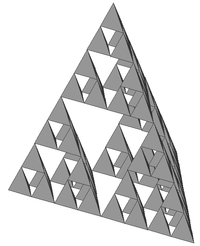Tetrahedral kite

A tetrahedral kite is a multicelled rigid box kite composed of tetrahedrally shaped cells to create a kind of tetrahedral truss. The cells are usually arranged in such a way that the entire kite is also a regular tetrahedron. The kite can be described as a compound dihedral kite as well.

This kite was invented by Alexander Graham Bell. It came about from his experiments with Hargrave's Box Kites and his attempts to build a kite that was scalable and big enough to carry both a man and a motor. As such, it was an early experiment on the road to manned flight. He worked on the kites between 1895 and 1910.[1] Bell wrote about his discovery of this concept in the June 1903 issue of National Geographic magazine; the article was titled "Tetrahedral Principle in Kite Structure".[2]
From an initial one cell model, Bell advanced to a 3,393 cell "Cygnet" model in 1907. This 40-foot (12.2 m) long, 200 pound (91 kilogram) kite was towed by a steamer offshore near Baddeck, Nova Scotia on 6 December 1907 and carried a man 168 feet (51.2 metres) above the water.
Bell also experimented with a large circular "tetrahedral truss" design during the same period.[3]
The tetrahedral kite, while not easy to make compared to the simple cross kite, is very stable and easy to fly. It flies well in moderate to heavy winds if it is properly set up.
See also
References
- ↑ "History of Aviation", GlobalAircraft.org 2008
- ↑ Alexander Graham Bell (June 1903) "Tetrahedral principle in kite structures," National Geographic Magazine, 14 (6) : 219-251. Also available on-line at: Catch-the-wind.de.
- ↑ "Inventions"National Geographic
